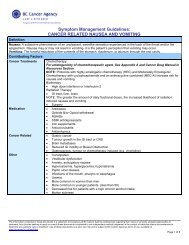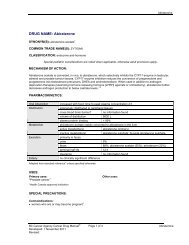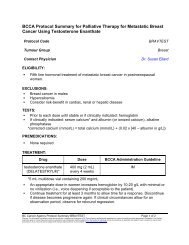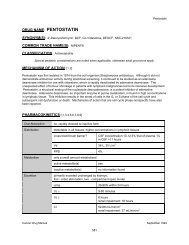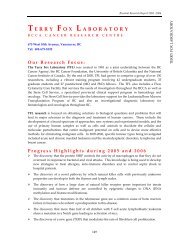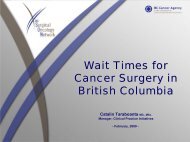Create successful ePaper yourself
Turn your PDF publications into a flip-book with our unique Google optimized e-Paper software.
<strong>Buserelin</strong><strong>DRUG</strong> <strong>NAME</strong>: <strong>Buserelin</strong>SYNONYM(S):COMMON TRADE <strong>NAME</strong>(S): SUPREFACT®, SUPREFACT® DEPOTCLASSIFICATION: hormonal agentSpecial pediatric considerations are noted when applicable, otherwise adult provisions apply.MECHANISM OF ACTION:<strong>Buserelin</strong> is a luteinizing hormone releasing hormone (LHRH) agonist. It is a synthetic analog of LHRH (also knownas gonadotropin releasing hormone [GnRH]). 1 LHRH agonists (LHRHa) initially stimulate the release of luteinizinghormone (LH, gonadotropin), resulting in a transient elevation in serum androgen in men and serum estradiol inwomen. However, chronic administration can cause down-regulation of the LHRH receptors, thus inhibiting thesecretion of LH and ultimately the sex hormones (androgen, estradiol). By decreasing the testicular production ofandrogen in men, LHRHa can inhibit the growth of androgen-dependent prostate cancer. Similarly, LHRHa reducethe ovarian secretion of estradiol and progesterone in women, 2 leading to inhibition of estrogen-dependent cancers.In men, LHRHa can reduce serum androgen to castrate level about 21 days after initiation of therapy. Similarly,serum estradiol level is suppressed in women around 4 weeks after initiation of treatment. LHRHa are 50-100 timesmore potent than LHRH. 3 In addition, they have a longer duration of action due to increased receptor affinity andgreater biological stability.PHARMACOKINETICS:Oral Absorption low, due to proteolysis in the GI tract 4Distributionhigh concentrations in liver; low concentrations in kidney, pituitary, thyroidcross blood brain barrier? yesvolume of distributionno information foundplasma protein binding 15% 5Metabolismliver, kidney, hypothalamus, pituitary gland 6 : enzymatic degradation by pyroglutamateaminopeptidase, endopeptidase, and post-proline-cleaving enzymes 4active metabolite(s)no information foundinactive metabolite(s)buserelin-(5-9)-pentapeptideExcretionrenalurine13-30%: 67% as buserelin, 32% as buserelin-(5-9)-pentapeptidefeces 7bile: unchanged drug and metabolitesterminal half life72-80 minclearanceno information foundAdapted from standard reference 5 unless specified otherwise.USES:Primary uses:Breast <strong>Cancer</strong> 8*Prostate cancer*Health Canada approved indicationOther uses:<strong>BC</strong> <strong>Cancer</strong> <strong>Agency</strong> <strong>Cancer</strong> Drug Manual © Page 1 of 8 <strong>Buserelin</strong>Developed: September 1994Revised: July 2007, 1 March 2012
<strong>Buserelin</strong>SPECIAL PRECAUTIONS:Contraindications:• history of hypersensitivity reaction to buserelin or any of its components, 1 other LHRHa, or LHRH 9• undiagnosed abnormal vaginal bleeding 10Caution:• history of heart disease or previous heart attack or stroke, cardiovascular risk factors (i.e., hypertension, highcholesterol, smoking), or diabetes 11-14 ; see paragraph after Side Effects table• long QT syndrome, electrolyte abnormalities, CHF, or concurrent administration with other QT prolongingdrugs 12-14 ; see paragraph after Side Effects tableDrug-induced disease flare: During the initial weeks of treatment, LHRHa may cause a worsening (flare) of thesymptoms of prostate or breast cancer. 9 Cases of spinal cord compression and/or ureteral obstruction have occurredin men with prostate cancer receiving LHRHa. These conditions require mandatory use of ketoconazole(NIZORAL®) (high dose) or anti-androgens, with LHRHa. 15 Administer with caution to patients at risk for developingthese conditions; e.g., patients with vertebral metastases. 16 For more information, see paragraph following SideEffects table.Changes in bone density: Decreased bone mineral density (BMD) may occur with buserelin therapy. 1,16 Use withcaution in patients with risk factors. For more information, see paragraph following Side Effects table.Transient hypercalcemia may develop after initiation of LHRHa in patients with bone metastases. 9Male breast cancer: At time of writing, use of LHRHa in male breast cancer is considered experimental. 17,18Carcinogenicity: Found to increase pituitary adenomas in rats treated with high doses of buserelin for durations >6months. 1Mutagenicity: Not mutagenic in Ames test and mammalian in vitro mutation test. 1 No information found forclastogenicity.Fertility: Ovulation is suppressed during treatment with buserelin. 10 Animal studies have shown decreased fertility inboth males and females while receiving buserelin.Pregnancy: Not available in the United States, therefore FDA Pregnancy Category has not been assigned.<strong>Buserelin</strong> is contraindicated in women who are pregnant, as it is not known if it can cause fetal abnormalities inhumans. 10 Non-hormonal methods of birth control should be used during therapy.Breastfeeding is not recommended due to the potential secretion into breast milk. 10SIDE EFFECTS:The table includes adverse events that presented during drug treatment but may not necessarily have a causalrelationship with the drug. Because clinical trials are conducted under very specific conditions, the adverse eventrates observed may not reflect the rates observed in clinical practice. Adverse events are generally included if theywere reported in more than 1% of patients in the product monograph or pivotal trials, and/or determined to beclinically important. 19,20 When placebo-controlled trials are available, adverse events are included if the incidence is>5% higher in the treatment group.ORGAN SITESIDE EFFECTClinically important side effects are in bold, italicsallergy/immunologyauditory/hearingallergic reactions, anaphylaxishearing disorders, tinnitus<strong>BC</strong> <strong>Cancer</strong> <strong>Agency</strong> <strong>Cancer</strong> Drug Manual © Page 2 of 8 <strong>Buserelin</strong>Developed: September 1994Revised: July 2007, 1 March 2012
<strong>Buserelin</strong>ORGAN SITESIDE EFFECTblood/bone marrow/febrile neutropeniacardiovascular(arrhythmia)cardiovascular (general)constitutional symptomsdermatology/skinendocrinegastrointestinalhemorrhageClinically important side effects are in bold, italicsanemia; males at increased risk 19leukopeniathrombocytopeniatachycardia (
<strong>Buserelin</strong>ORGAN SITESIDE EFFECTneurologyocular/visualpainpulmonaryrenal/genitourinaryClinically important side effects are in bold, italicsfracture, 24,25 increased risk; duration-relatedloss of muscle mass; males at increased risk 19shoulder pain/stiffness (female)anxiety, emotional lability, mood changesdepression (
<strong>Buserelin</strong>Drug-induced disease flare: New or worsening signs and symptoms of prostate or breast cancer may occur in theinitial weeks of buserelin therapy. 9,33,34 The flare is a result of the buserelin-induced increase in androgen (in men)and estradiol (in women) during the initial weeks of therapy, prior to LHRH down-regulation.In men, symptoms may include: acute exacerbation of bone pain, spinal cord compression 4 , urinary retention,urethral obstruction 9 , lymphedema. 35 Blockage of flare in men can be achieved using anti-androgens (e.g., flutamide,bicalutamide, nilutamide, cyproterone) concurrent with the first administration of buserelin. 9,35 Flare is experiencedsignificantly less frequently today due to the use of anti-androgens and the initiation of LHRHa earlier in thetreatment of prostate cancer.In women, symptoms may include 34,36 : acute exacerbation of bone pain, skin erythema, increase in the size and/ornumber of metastatic skin nodules. There are currently no agents available to achieve blockage of flare in women.Treatment of flare may include the use of analgesics for pain.Vaginal bleeding, or breakthrough bleeding, may frequently occur during early buserelin therapy. The normalmenstrual cycle consists of a follicular, or proliferative, phase and a luteal, or post-ovulatory, phase. 37,38Increasing levels of estrogen in the follicular phase lead to maturation of the follicle and proliferation of the uterinemucosa, while decreasing levels of hormone in the luteal phase lead to sloughing of the endometrium (menses). Atthe initiation of therapy, menses may still occur as estrogen levels fall, particularly if treatment was started in theluteal phase of the menstrual cycle. It may also be possible that the initial buserelin-induced estrogen increase (flare)will induce the follicular phase of the menstrual cycle; again, menses will occur as estrogen levels fall. Therefore,one or two menses could be expected following the start of therapy. There is still potential for pregnancy to occurearly after initiation.A possible increased risk of myocardial infarction, sudden cardiac death, and stroke has been associated withandrogen deprivation therapy in men, possibly due to effects on traditional cardiovascular risk factors, includingserum lipoproteins, insulin sensitivity, and obesity. Monitor for signs and symptoms suggestive of cardiovasculardisease and manage according to current clinical practice. Risk of treatment should be weighed against risk ofdisease. Androgen deprivation therapy also has the potential to prolong QT/QTc interval on ECG; therefore,concurrent therapy with other QT prolonging drugs may increase the risk of potentially fatal arrhythmias. Assesspatients with long QT syndrome, electrolyte abnormalities, or CHF for increased cardiovascular risk. 11-14Cardiovascular risk in women is unknown.INTERACTIONS:No documented drug interactions. 1SUPPLY AND STORAGE:Nasal solution 10 : sanofi-aventis Canada Inc. supplies 1 mg/mL solution in a 10 mL bottle for intranasaladministration and includes a metered-dose pump or nebulizer. Each pump action delivers 100 mcg buserelin or 0.1mL solution. Store at room temperature in the original container; do not freeze; protect from light.Injection: sanofi-aventis Canada Inc. supplies 3 products 1,10 :• 1 mg/mL in 5.5 mL multi-dose vials for subcutaneous administration. Selected non-medicinal ingredients: benzylalcohol. Store at room temperature in the original container; do not freeze; protect from light.• 6.3 mg (2-month) depot and 9.45 mg (3-month) depot for subcutaneous administration. 1 The 2-month depotcontains 1 implantable dose consisting of 2 identical cylindrical rods. The 3-month depot contains 1 implantabledose consisting of 3 identical cylindrical rods. Both are available as a pre-filled syringe. Store at room temperaturein the original container; protect from heat.<strong>BC</strong> <strong>Cancer</strong> <strong>Agency</strong> <strong>Cancer</strong> Drug Manual © Page 5 of 8 <strong>Buserelin</strong>Developed: September 1994Revised: July 2007, 1 March 2012
<strong>Buserelin</strong>PARENTERAL ADMINISTRATION:<strong>BC</strong>CA administration guideline noted in bold, italicsSubcutaneous • non-depot injection 10• depot injection into the lateral abdominal wall 2Intramuscularno information foundDirect intravenousno information foundIntermittent infusionno information foundContinuous infusionno information foundIntraperitonealno information foundIntrapleuralno information foundIntrathecalno information foundIntra-arterialno information foundIntravesicalno information foundDOSAGE GUIDELINES:Refer to protocol by which patient is being treated. Numerous dosing schedules exist and depend on disease,response and concomitant therapy. Guidelines for dosing also include consideration of absolute neutrophil count(ANC). Dosage may be delayed or discontinued in patients with bone marrow depression due to cytotoxic/radiationtherapy or with other toxicities.Adults:<strong>BC</strong>CA usual dose noted in bold, italicsCycle Length:Subcutaneous: daily 10 : • initial therapy: 500 mcg (0.5 mL) SC every 8 hours for 7consecutive days starting on day 1• maintenance therapy: 200 mcg (0.2 mL) SC as a singledaily dosen/a 8 :6.3 mg depot injection SC every 6 weeks for 2 treatments,then every 8 weeksOnce clinical response has been established, maysubstitute 9.45 mg depot injection SC every 12 weeks.8 weeks 39 : 6.3 mg depot injection SC for one dose on day 1(total dose per cycle 6.3 mg)12 weeks 39 : 9.45 mg depot injection SC for one dose on day 1(total dose per cycle 9.45 mg)Intranasal: daily 10 : • initial therapy: use subcutaneous route, as above• maintenance therapy: 400 mcg (200 mcg into each nostril)three times daily using metered-dose pump (nebulizer)Concurrent radiation: no dosing adjustment required 20Dosage in myelosuppression:Dosage in renal failure:modify according to protocol by which patient is being treated; if no guidelinesavailable, refer to Appendix 6 "Dosage Modification for Myelosuppression"no information found<strong>BC</strong> <strong>Cancer</strong> <strong>Agency</strong> <strong>Cancer</strong> Drug Manual © Page 6 of 8 <strong>Buserelin</strong>Developed: September 1994Revised: July 2007, 1 March 2012
<strong>Buserelin</strong>Dosage in hepatic failure:Dosage in dialysis:Cycle Length:no information foundno information found<strong>BC</strong>CA usual dose noted in bold, italicsChildren:no information found for the use of buserelin in oncologyREFERENCES:1. sanofi-aventis Canada Inc. SUPREFACT® DEPOT 2 months and SUPREFACT® DEPOT 3 months product monograph. Laval,Quebec; 26 April 2006.2. Tyrrell JB, Findling JW, Aron DC. Hypothalamus and pituitary. Basic and Clinical Endocrinology. 4th ed. Norwalk, Connecticut:Appleton and Lange; 1994. p. 81-82.3. Engel JB, Schally AV, Engel JB, et al. Drug Insight: clinical use of agonists and antagonists of luteinizing-hormone-releasinghormone. Nat Clin Pract Endocrinol Metab 2007;3(2):157-67.4. Chabner BA, Longo DL. <strong>Cancer</strong> Chemotherapy and Biotherapy. 3rd ed. Philadelphia, Pennsylvania: Lippincott Williams &Wilkins; 2001. p. 95-97.5. <strong>DRUG</strong>DEX Evaluations [database on the Internet]. <strong>Buserelin</strong>. Thomson MICROMEDEX®, 2007. Available at:http://www.micromedex.com/, 2 April 2007.6. DeVita VT, Hellman S, Rosenberg SA. <strong>Cancer</strong> Principles & Practice of Oncology. 6th ed. Philadelphia: Lippincott Williams &Wilkins; 2001. p. 483-484.7. MARTINDALE- The Complete Drug Reference [database on the Internet]. <strong>Buserelin</strong>. Thomson MICROMEDEX®, 2007.Available at: http://www.micromedex.com/;. Accessed 2 April 2007.8. <strong>BC</strong> <strong>Cancer</strong> <strong>Agency</strong> Breast Tumour Group. (BRAVLHRHT) <strong>BC</strong>CA Protocol Summary for Palliative Therapy for Breast <strong>Cancer</strong>Using LHRH agonist and Tamoxifen. Vancouver, British Columbia: <strong>BC</strong> <strong>Cancer</strong> <strong>Agency</strong>; 1 June 2006.9. McEvoy GK, editor. AHFS 2006 Drug Information. Bethesda, Maryland: American Society of Health-System Pharmacists, Inc. p.1064-1066.10. sanofi-aventis Canada Inc. SUPREFACT® product monograph; buserelin acetate injection; buserelin acetate nasal solution.Laval, Quebec; 8 May 2006.11. Health Canada. MedEffect® e-Notice - GnRH agonists: Heart-related Risk in Men Treated for Prostate <strong>Cancer</strong>. 8 September2011. Available at: http://www.hc-sc.gc.ca/ahc-asc/media/advisories-avis/.12. sanofi-aventis Canada Inc. ELIGARD® product monograph. Laval, Quebec; 31 May 2011.13. Abbott Laboratories Limited. LUPRON® and LUPRON DEPOT® product monograph. St-Laurent, Quebec; 2 September 2011.14. sanofi-aventis Canada Inc. SUPREFACT® product monograph. Laval, Quebec; 10 August 2010.15. Judy Sutherland MD. Personal communication. <strong>BC</strong> <strong>Cancer</strong> <strong>Agency</strong> Genitourinary Tumour Group.; 16 June 2007.16. AstraZeneca Canada Inc. ZOLADEX® product monograph. Mississauga, Ontario; 8 June 2004.17. Giordano SH, Hortobagyi GN. Leuprolide Acetate Plus Aromatase Inhibition for Male Breast <strong>Cancer</strong>. J Clin Oncol2006;24(21):42e-43.18. Susan Ellard MD. Personal communication. <strong>BC</strong> <strong>Cancer</strong> <strong>Agency</strong> Breast Tumour Group; 25 June 2007.19. Susan Ellard MD. Personal communication. <strong>BC</strong> <strong>Cancer</strong> <strong>Agency</strong> Breast Tumour Group.; 10 May 2007.20. Tom Pickles MD. Personal communication. <strong>BC</strong> <strong>Cancer</strong> <strong>Agency</strong> Genitourinary Tumour Group.; 24 April 2007.21. Keating NL, O'Malley AJ, Smith MR, et al. Diabetes and cardiovascular disease during androgen deprivation therapy forprostate cancer. J Clin Oncol 2006;24(27):4448-56.22. <strong>BC</strong> <strong>Cancer</strong> <strong>Agency</strong> Provincial Systemic Therapy Program. Provincial Systemic Therapy Program Policy III-20: Prevention andmanagement of extravasation of chemotherapy. Vancouver, British Columbia: <strong>BC</strong> <strong>Cancer</strong> <strong>Agency</strong>; 1 September 2006.23. <strong>BC</strong> <strong>Cancer</strong> <strong>Agency</strong>. (SCNAUSEA) Guidelines for Prevention and Treatment of Chemotherapy-induced Nausea and Vomiting inAdults. Vancouver, British Columbia: <strong>BC</strong> <strong>Cancer</strong> <strong>Agency</strong>; 1 November 2005.24. Smith MR, Lee WC, Brandman J, et al. Gonadotropin-releasing hormone agonists and fracture risk: a claims-based cohortstudy of men with nonmetastatic prostate cancer. J Clin Oncol 2005;23(31):7897-903.25. Shahinian VB, Kuo YF, Freeman JL, et al. Risk of fracture after androgen deprivation for prostate cancer. N Engl J Med2005;352(2):154-64.26. Chabner BA, Longo DL. <strong>Cancer</strong> Chemotherapy and Biotherapy. 3rd ed. Philadelphia, Pennsylvania: Lippincott Williams &Wilkins; 2001. p. 116-117.27. Mottet N, Prayer-Galetti T, Hammerer P, et al. Optimizing outcomes and quality of life in the hormonal treatment of prostatecancer. BJU International 2006;98(1):20-7.28. Theriault RL. Strategies to prevent chemotherapy-induced bone loss in women with breast cancer. Clin Breast <strong>Cancer</strong> 2005;5Suppl(2):S63-70.29. Smith MR. Therapy Insight: osteoporosis during hormone therapy for prostate cancer. Nat Clin Pract Urol 2005;2(12):608-615;quiz 28.<strong>BC</strong> <strong>Cancer</strong> <strong>Agency</strong> <strong>Cancer</strong> Drug Manual © Page 7 of 8 <strong>Buserelin</strong>Developed: September 1994Revised: July 2007, 1 March 2012
<strong>Buserelin</strong>30. Smith MR. Diagnosis and management of treatment-related osteoporosis in men with prostate carcinoma. <strong>Cancer</strong> 2003;97(3Suppl):789-95.31. Brown JP, Josse RG. 2002 clinical practice guidelines for the diagnosis and management of osteoporosis in Canada. CMAJ2002;167(90100):1S-34.32. <strong>BC</strong> <strong>Cancer</strong> <strong>Agency</strong> Genitourinary Tumour Group. Osteoporosis Screening Guidelines. Vancouver, British Columbia: <strong>BC</strong><strong>Cancer</strong> <strong>Agency</strong>; 25 April 2007.33. Emens LA, Davidson NE. Adjuvant Hormonal Therapy for Premenopausal Women with Breast <strong>Cancer</strong>. Clin <strong>Cancer</strong> Res2003;9(1):486S-494.34. Clarysse A. Hormone-induced Tumor Flare. Eur J <strong>Cancer</strong> Clin Oncol 1984;21(5):545-547.35. Thompson I. Flare Associated with LHRH-Agonist Therapy. Rev Urol 2001;3(Suppl 3):S10-S14.36. Rose BD editor. Endocrine Therapy of Metastatic Breast <strong>Cancer</strong>. UpToDate 15.1 ed. Waltham, Massachusetts: UpToDate®;2007.37. Underwood JCE, editor. General and Systemic Pathology. 3rd ed. Edinburgh, London, New York, Philadelphia, St Louis,Sydney, Toronto: Churchill Livingstone; 2000. p. 330-340.38. Koda-Kimble MA, Young LY, editors. Applied Therapeutics. 7th ed. Baltimore Maryland: Lippincott Williams & Wilkins; 2001. p.43-2,3,4.39. <strong>BC</strong> <strong>Cancer</strong> <strong>Agency</strong> Genitourinary Tumour Group. (GUPLHRH) <strong>BC</strong>CA Protocol Summary for Therapy for Prostate <strong>Cancer</strong>Using LHRH Agonist (Goserelin, Leuprolide or <strong>Buserelin</strong>). Vancouver, British Columbia: <strong>BC</strong> <strong>Cancer</strong> <strong>Agency</strong>; 1 February 2007.<strong>BC</strong> <strong>Cancer</strong> <strong>Agency</strong> <strong>Cancer</strong> Drug Manual © Page 8 of 8 <strong>Buserelin</strong>Developed: September 1994Revised: July 2007, 1 March 2012




